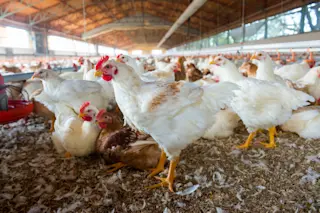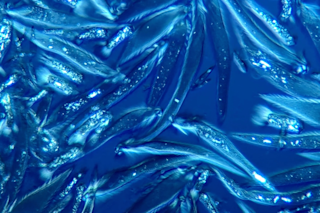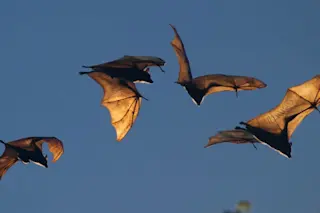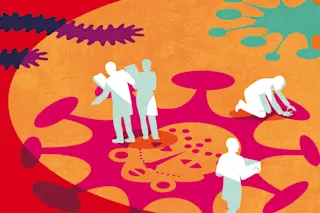This is the seventh of eight posts on evolutionary research to celebrate Darwin's bicentennial. It combines many of my favourite topics - symbiosis, horizontal gene transfer, parasitic wasps and viruses.

Parasitic wasps make a living by snatching the bodies of other insects and using them as living incubators for their grubs. Some species target caterpillars, and subdue them with a biological weapon. They inject the victim with "virus-like particles" called polydnaviruses (PDVs), which weaken its immune system and leave the wasp grub to develop unopposed. Without the infection, the wasp egg would be surrounded by blood cells and killed.
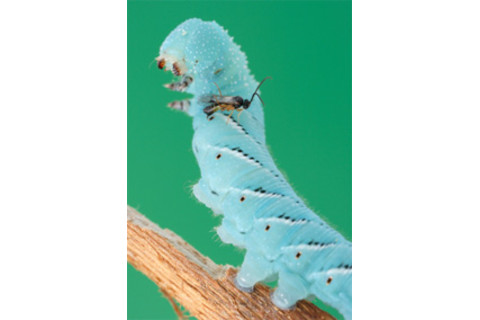
The wasps' partners in body-snatching are very different to all other viruses. Once they have infected other cells, they never use the opportunity to make more copies of themselves. They actually can't. To complete their life cycles, viruses need to package their genetic material within a coat made of proteins. In most cases, the instructions for building these coats are encoded within the virus's genome, but polydnaviruses lack these key instructions entirely. Without them, the virus is stuck within whatever cell it infects.
It's such a weird set-up that some scientists have questioned whether the polydnaviruses actually count as viruses at all or whether they are "genetic secretions" from the wasps themselves. Where on earth are those missing coat genes?
Annie Bezier form Francois Rabelais University has found the answer and it's an astonishing one. The viruses' coat genes haven't disappeared - they've just been relocated to the genomes of their wasp hosts.
In this way, the wasps and the viruses have formed an unbreakable alliance, where neither can survive without the other's help. Without the virus, the next generation of wasps would be overwhelmed by the defences of their caterpillar larders. Without the wasp, the virus would never be able to reproduce. Some viruses may be able to live happily alongside their host with little ill effect; others may even be beneficial in some way. But this is the first example of a virus co-evolving with its host in a compulsory binding pact.
Secret origins
The polydnaviruses were first observed in 1967 within the ovaries of parasitic wasps. From this storage facility, these biological weapons can be easily injected into a host, for the wasp's sting is just a modified version of her egg-laying tube. Bezier knew that when the viruses are first produced in the wasp ovaries, they come complete with coats, so the genes for building these must lie nearby.
She searched for virus-related genes that were switched on in the ovaries of two parasitic wasps from the braconid group - Cotesia congregataand Chelonus inanitus. It wasn't long before she found some - 22 potential genes that strongly resembled genes from another group of viruses called nudiviruses. Sure enough, some of these 22 genes encode proteins that form viral coats, and others encoded proteins responsible for assembling the virus particles together. These initial results strongly implied that the polydnaviruses are descendants of the nudivirus family .
Nudiviruses infect insects, so Bezier needed to make sure that the genes she was picking up hadn't just come from an infection that her wasps had picked up in her laboratory. Fortunately for her theory, she managed to find some of the same genes in eight species of braconid wasp collected from all over the world. And when she sequenced large tracts of C.congregata's genome, she found that at least 10 nudivirus-related genes had been fully integrated into the insect's chromosomes. These were no temporary hitchhikers - they were clearly stable parts of the wasp's genome.
Bezier went on to show that these nudivirus-related genes, hidden among the wasp genomes, were switched on when the adult wasps were still tucked away in their pupae. That's exactly the time when the polydnaviruses are first assembled. The genes are even switched on the exact spot in the wasp ovaries where the virus particles are produced. And to top it all off, Bezier found that 20 of these ex-nudiviral genes encoded proteins that make up part of the polydnavirus coat. It was the final proof she needed. The wasp genomes clearly contain ex-viral genes, which complete the assembly process that polydnaviruses can't finish themselves.

Evolution of a partnership
The two wasps that Bezier studied hail from distantly related arms of the braconid family tree, which suggests that all the wasps of this group have nudiviral machinery incorporated into their genomes. Bezier thinks that the bond between wasp and virus was forged at least 100 million years ago, before the braconid wasp lineage had started to expand.
The genetic evidence suggests all the virus genes in today's wasps are the descendants of a single ancestral nudivirus that integrated itself into the genomes of an ancestral wasp. Many of these transferred genes are still incredibly similar across different species, suggesting that some aspects of the wasp-virus union are so important that they are resistant to change. Others have diverged more thoroughly and Bezier thinks that these are probably responsible for more specific interactions between virus and host.
In contrast, the polydnaviruses actually share very little of their own DNA. As an example, the strains used by C.congregata and C.inanitus hardly have any genes in common, even though their respective wasps use very similar coat-producing genes. Bezier thinks that many of the genes within the polydnaviruses aren't viral at all - they actually came from the wasp.
When the ancestral nudivirus infected the ancestral wasp, the two partners did a massive genetic swap, with wasp genes replacing viral ones and viral genes infiltrating the wasp genome. The virus has become a vehicle that allows the wasp to switch on its own genes within the body of a caterpillar. It's possible that this partnership was one of the reasons why the braconid wasps became such successful parasites and why today, there are at least 17,500 species of them.
Reference: Science 10.1126/science.1166788
Images: Photo by Alex Wild
More on parasitic wasps:
How diversity creates itself - cascades of new species among flies and parasitic wasps
Parasitic wasp turns caterpillars into head-banging bodyguards
More on horizontal gene transfer:
Who needs sex? - Rotifers import genes from fungi, bacteria and plants
Solar-powered green sea slug steals ability to photosynthesise from algae



